Wabi-sabi celebrates the beauty of imperfection and the simplicity found in nature. In this collection, we showcase 20 designs that embody this philosophy, highlighting unique aesthetics and materials that embrace the charm of the unfinished and organic. These inspirations offer a refreshing take on decor that invites warmth and character into any space.
Handcrafted Pottery and Ceramics
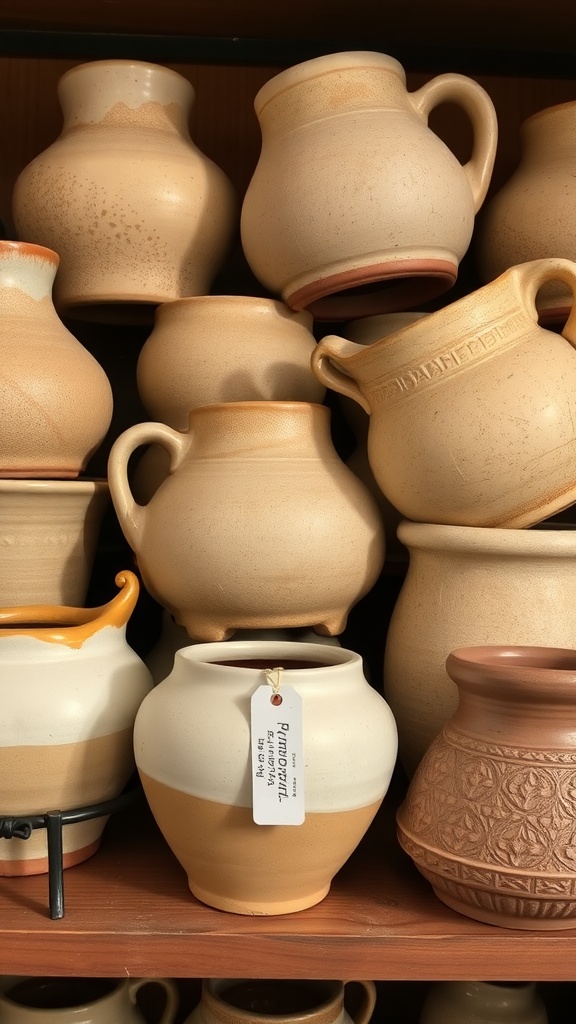
Handcrafted pottery and ceramics embody the essence of wabi-sabi, celebrating imperfections and the beauty of natural materials. The image showcases a collection of unique pots, each with its own character. The subtle variations in color and texture tell stories of their creation.
These pieces are not just functional; they are art. The gentle curves and earthy tones invite a sense of warmth into any space. Each pot has a story, reflecting the hands that shaped it. The craftsmanship shines through, making every piece special.
Using handcrafted pottery in your home adds a personal touch. Whether it’s a vase for fresh flowers or a bowl for fruit, these items enhance your decor with their organic charm. They remind us to appreciate the beauty in simplicity and the passage of time.
The Beauty of Weathered Materials
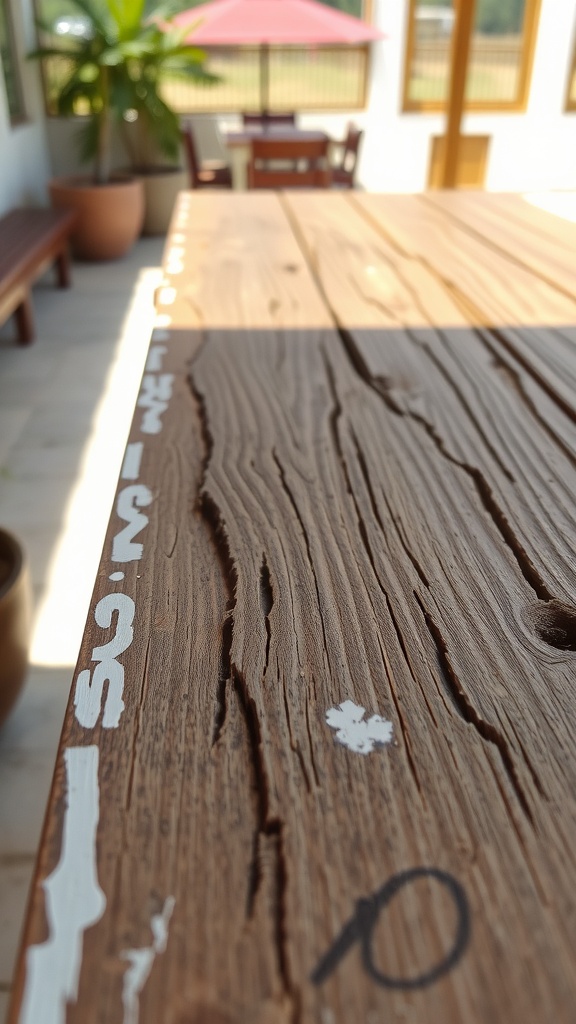
Weathered materials have a charm that’s hard to resist. Take a look at the image of this beautifully aged wooden table. The texture tells a story of time, with grooves and marks that add character. Each line and imperfection is a reminder of its journey.
The natural wear and tear create a sense of warmth. This table invites gatherings and shared moments. It’s not just a piece of furniture; it’s a centerpiece for memories. The subtle colors and patterns make it visually appealing, blending seamlessly into various design styles.
Incorporating weathered materials into your space can enhance its aesthetic. They bring a touch of nature indoors, creating a calming atmosphere. Whether it’s a rustic dining table or reclaimed wood accents, these elements add depth and personality to any room.
Minimalist Wabi-Sabi Spaces
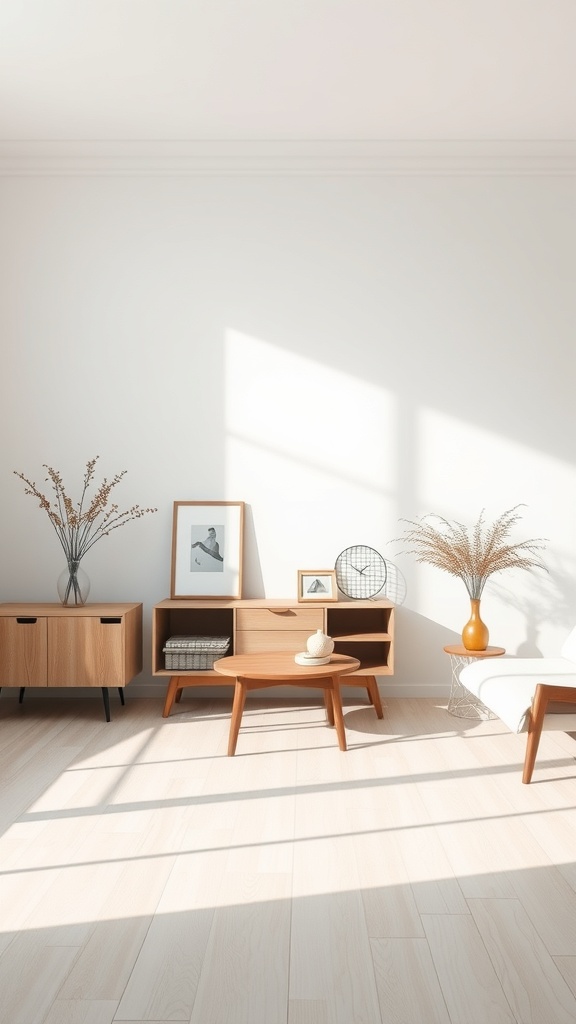
Minimalist Wabi-Sabi spaces are all about simplicity and natural beauty. The image showcases a serene room filled with light and warmth. The wooden furniture adds a touch of nature, while the clean lines keep things uncluttered.
The soft color palette creates a calm atmosphere. The sunlight streaming in highlights the textures of the wood and the delicate plants. This blend of elements reflects the Wabi-Sabi philosophy, which finds beauty in imperfection and transience.
In such spaces, every item has a purpose and a story. The carefully chosen decor, like the simple vase and the framed art, enhances the overall aesthetic without overwhelming it. This balance makes the room feel inviting and peaceful, perfect for relaxation or reflection.
Natural Textures in Home Decor
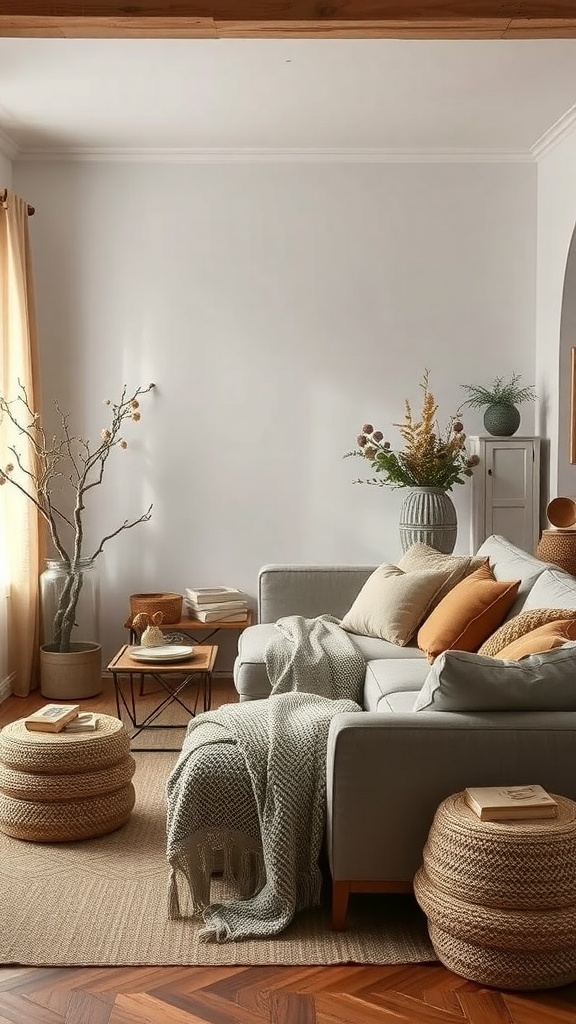
Natural textures play a big role in creating a cozy and inviting space. In the image, we see a living room that beautifully showcases this idea. The soft gray sofa is adorned with warm, earthy-toned pillows, adding comfort and style.
The woven elements, like the round poufs and the basket, bring a tactile quality to the room. These pieces not only look great but also add depth and warmth. The use of natural materials like wood and fabric makes the space feel grounded and connected to nature.
Plants and dried flowers in simple vases add a touch of life without overwhelming the decor. The light streaming through the curtains enhances the natural feel, creating a serene atmosphere. Overall, this room is a perfect example of how natural textures can elevate home decor.
Rustic Elements in Urban Interiors
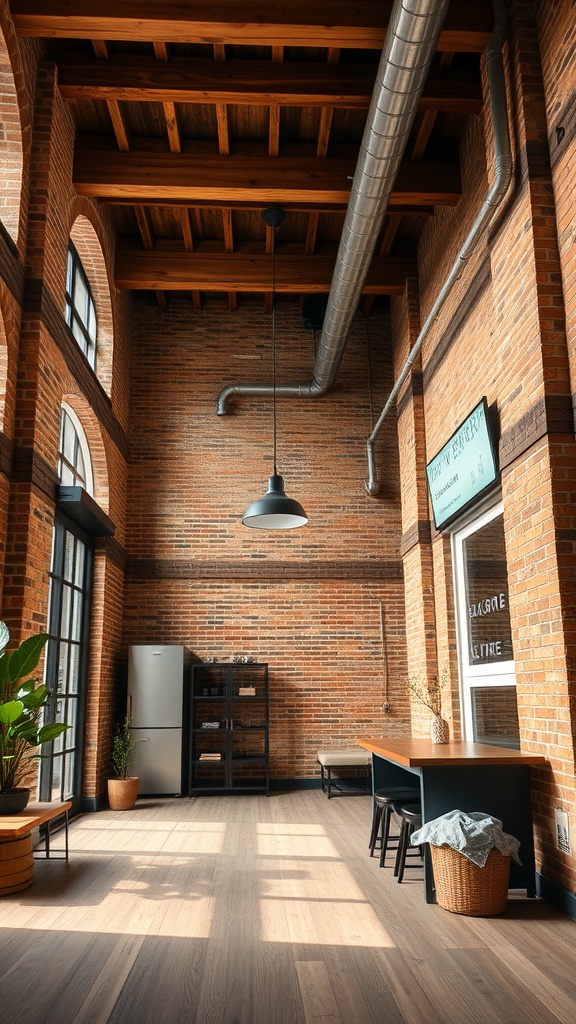
Urban interiors often blend modern design with rustic charm. The image showcases a spacious room with exposed brick walls and wooden beams, creating a warm and inviting atmosphere. This combination of materials highlights the beauty of imperfections, a key aspect of wabi-sabi design.
The large windows allow natural light to flood the space, enhancing the earthy tones of the brick and wood. A simple wooden table and black chairs provide a functional yet stylish dining area. The greenery adds a touch of life, bridging the gap between the urban environment and nature.
Rustic elements like the metal light fixture and the open shelving unit contribute to the overall aesthetic. They remind us that beauty can be found in simplicity and authenticity. This space is a perfect example of how rustic design can thrive in an urban setting, creating a cozy retreat amidst the hustle and bustle.
Embracing Imperfections in Furniture
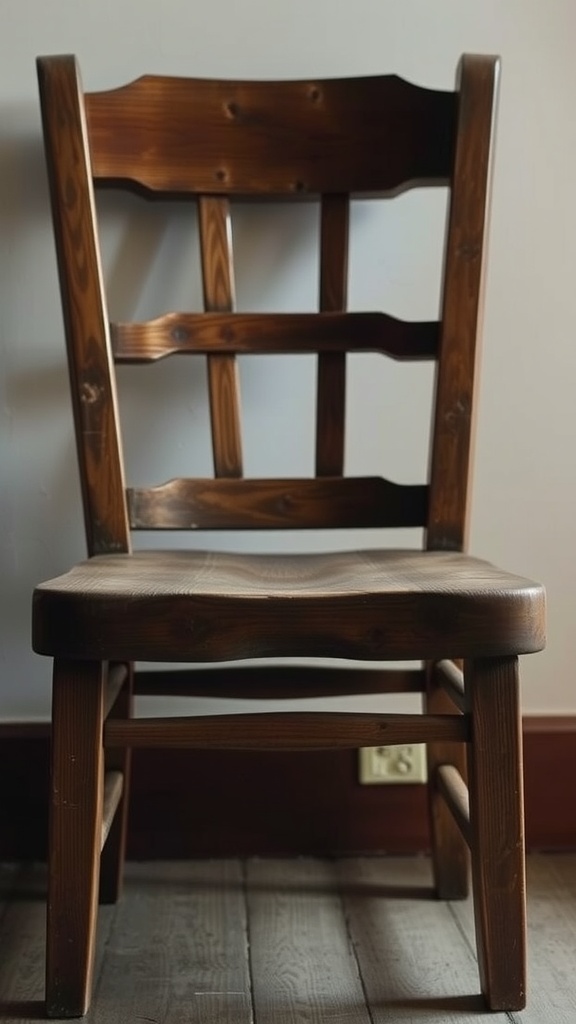
The charm of wabi-sabi lies in its celebration of imperfections, and this wooden chair is a perfect example. Its rustic look tells a story of time and use, showcasing how beauty can be found in wear and tear.
This chair features a unique design with a slightly uneven seat and visible wood grain. These characteristics highlight the natural materials and craftsmanship behind the piece. Instead of seeking perfection, this design invites us to appreciate the small flaws that make it special.
Incorporating such furniture into your home can create a warm and inviting atmosphere. Each scratch and dent adds character, making the space feel lived-in and authentic. Choosing pieces like this chair encourages a mindset that values authenticity over uniformity.
Wabi-sabi furniture can be a conversation starter, sparking discussions about its history and the journey it has taken. Embracing these imperfections not only enhances your decor but also reflects a deeper appreciation for the beauty of life’s transient nature.
Subtle Color Palettes Inspired by Nature
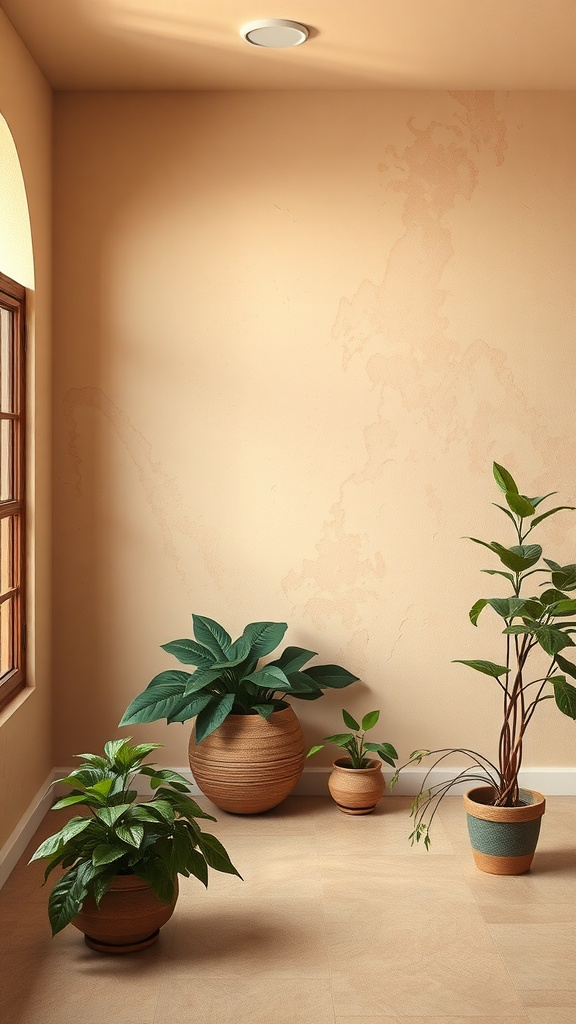
In this serene space, soft, earthy tones create a calming atmosphere. The warm peach walls blend beautifully with the natural light streaming in through the window. This gentle color palette reflects the essence of wabi-sabi, celebrating simplicity and the beauty of imperfection.
The plants add a touch of life and vibrancy. Each pot, with its unique texture and shape, complements the overall design. The larger plant in the round pot stands out, while the smaller ones create a harmonious balance. This arrangement invites a sense of tranquility, making it a perfect spot for relaxation or contemplation.
This design showcases how subtle colors can transform a space. By drawing inspiration from nature, the room feels inviting and grounded. It’s a reminder that beauty can be found in simplicity and the natural world.
Organic Shapes in Architecture

Organic shapes in architecture bring a refreshing twist to traditional designs. The image showcases a unique structure that flows gracefully with its surroundings. Its smooth, curvy lines create a sense of harmony, blending seamlessly with the natural landscape.
The building’s design resembles natural forms, making it feel alive and inviting. This approach reflects the principles of wabi-sabi, celebrating imperfection and the beauty of nature. The soft curves contrast sharply with the rigid lines often seen in conventional buildings, offering a more relaxed and approachable aesthetic.
Surrounding the structure, the pathway made of stone slabs leads visitors gently toward the entrance. This thoughtful landscaping enhances the organic feel, encouraging a connection with nature. The sparse trees and grass add to the serene atmosphere, making it a perfect spot for relaxation and contemplation.
Natural Light and Shadows
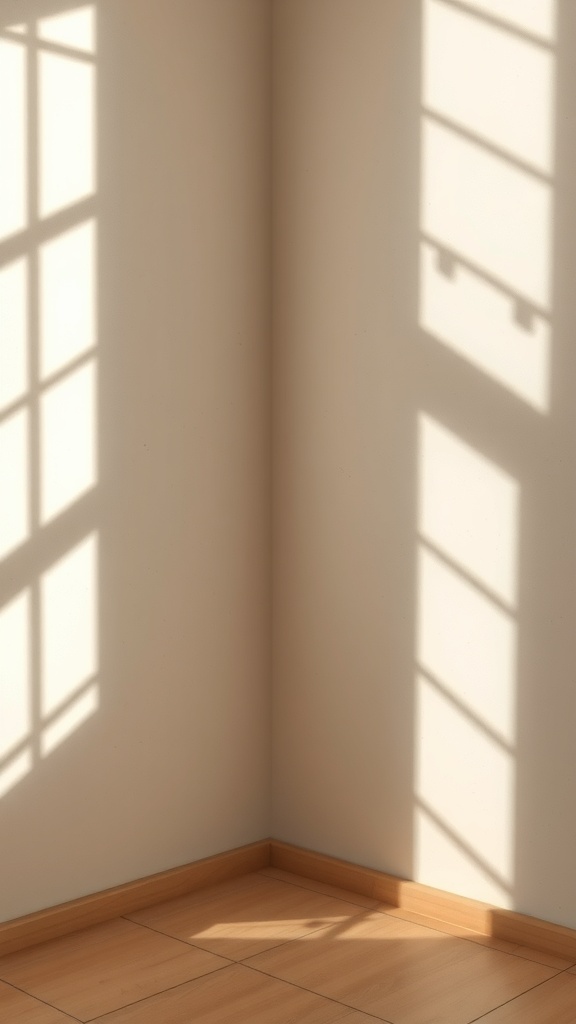
Natural light plays a big role in wabi-sabi design. It brings warmth and life to a space. In this image, we see soft shadows cast on a simple wall. The light creates a calming atmosphere, highlighting the beauty of imperfection.
Shadows can add depth and character to a room. They change throughout the day, offering a dynamic view. This constant shift reminds us of the beauty in change, a key principle of wabi-sabi.
Using natural light effectively can enhance the overall feel of a space. It invites the outdoors in, making the environment feel more connected and alive. Embracing these elements can truly transform a home into a serene retreat.
The Charm of Vintage Finds

Vintage items have a unique charm that brings warmth to any space. The image showcases a delightful arrangement of clocks and books, each telling its own story. The clocks, with their classic designs, remind us of simpler times. They stand as symbols of nostalgia, evoking memories of family gatherings and quiet moments.
The stacked books, with their worn covers and faded spines, add to the character of the scene. Each book holds the potential for new adventures, waiting to be opened and explored. This collection creates a cozy atmosphere, perfect for curling up with a good read.
Incorporating vintage finds into your home decor can create a sense of history and personality. These pieces not only serve a purpose but also spark conversations. They remind us that beauty can be found in the imperfections of time.
Sustainable and Eco-Friendly Materials
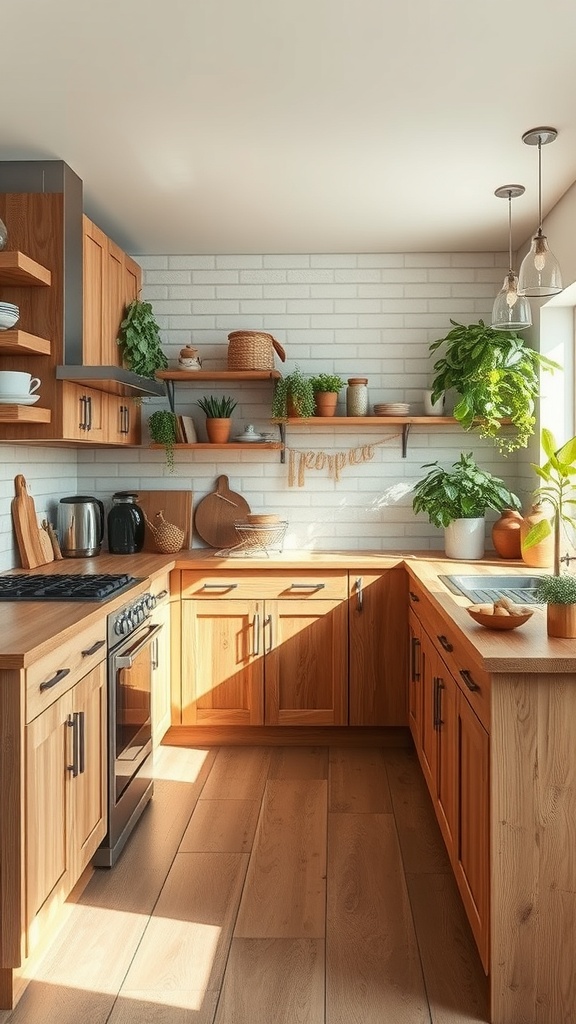
The image showcases a beautifully designed kitchen that embodies the principles of wabi-sabi. The warm wooden cabinets and countertops create a cozy atmosphere, while the natural light streaming in adds a touch of serenity. This space highlights how sustainable materials can be both functional and aesthetically pleasing.
Using eco-friendly materials is a key aspect of wabi-sabi design. The wood in this kitchen likely comes from responsibly sourced forests, ensuring minimal environmental impact. This choice not only supports sustainability but also adds character to the space, as each piece of wood has its unique grain and texture.
Incorporating plants into the design, as seen here, enhances the connection to nature. They not only purify the air but also bring life and color to the kitchen. This blend of natural elements creates a calming environment, perfect for cooking and gathering.
Choosing materials that age gracefully is another important factor. The wood will develop a patina over time, telling a story of its own. This aligns perfectly with the wabi-sabi philosophy, which embraces imperfection and the beauty of aging.
Layering Textures for Depth
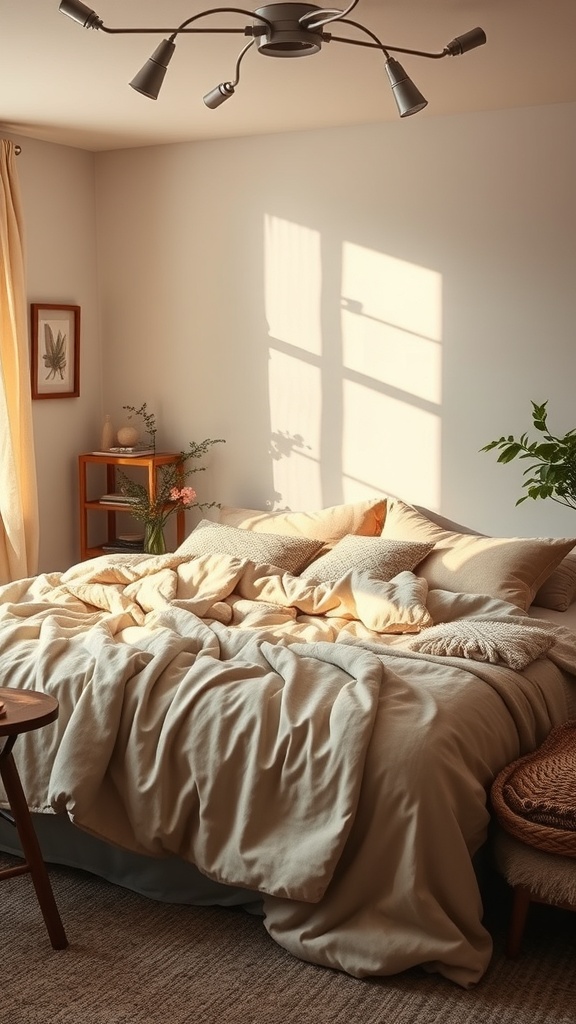
In the realm of Wabi-Sabi design, layering textures is key to creating a cozy and inviting space. The image captures a beautifully arranged bedroom, showcasing how different materials can come together harmoniously.
The bed is dressed in soft, neutral linens that invite relaxation. The crumpled blankets and various cushions add depth and comfort, making the space feel lived-in and warm. This casual arrangement speaks to the beauty of imperfection, a core principle of Wabi-Sabi.
Natural elements, like the potted plant and wooden furniture, enhance the organic feel of the room. The sunlight filtering through the window casts gentle shadows, further emphasizing the textures at play. This interplay of light and shadow adds another layer of visual interest.
Incorporating different textures, such as the woven basket and the smooth surfaces of the furniture, creates a balanced aesthetic. Each element contributes to a sense of calm and tranquility, perfect for unwinding after a long day.
The Aesthetic of Asymmetry
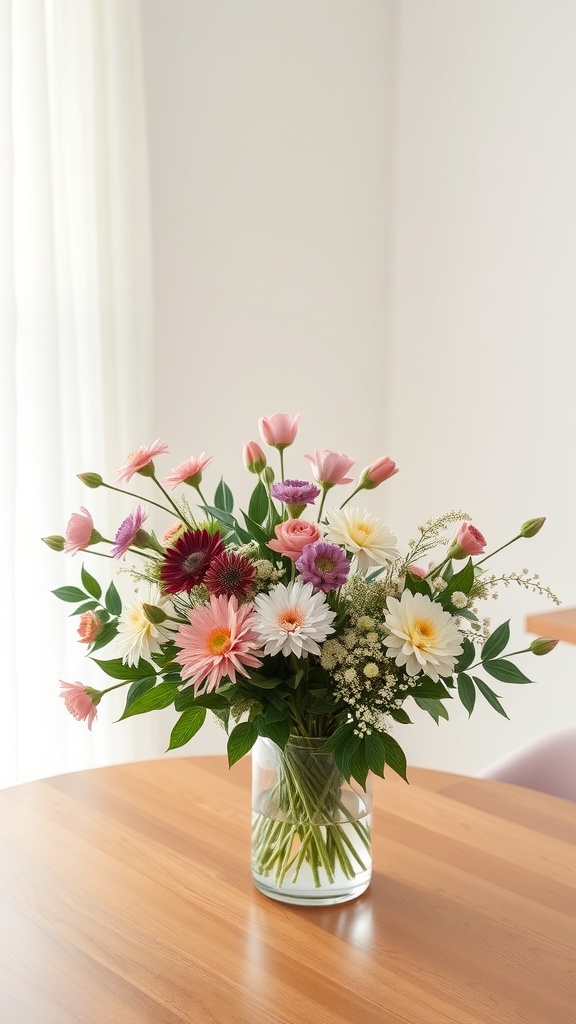
Wabi-sabi embraces the beauty of imperfection, and asymmetry plays a big role in this philosophy. The image showcases a lovely bouquet of flowers in a simple glass vase. The arrangement is not uniform, with flowers of varying heights and shapes. This creates a natural, effortless look that feels inviting.
The soft colors of the flowers, including pinks, whites, and purples, add a gentle touch to any space. The way the flowers are grouped together, with some standing taller and others nestled lower, highlights the charm of asymmetry. It reminds us that beauty often lies in the unexpected.
Incorporating asymmetrical designs into your home can create a relaxed atmosphere. Whether it’s through floral arrangements, furniture placement, or decor, embracing this aesthetic can make your space feel more organic and alive. So, next time you arrange flowers or decorate a room, think about how a little asymmetry can bring warmth and character.
Celebrating the Passage of Time
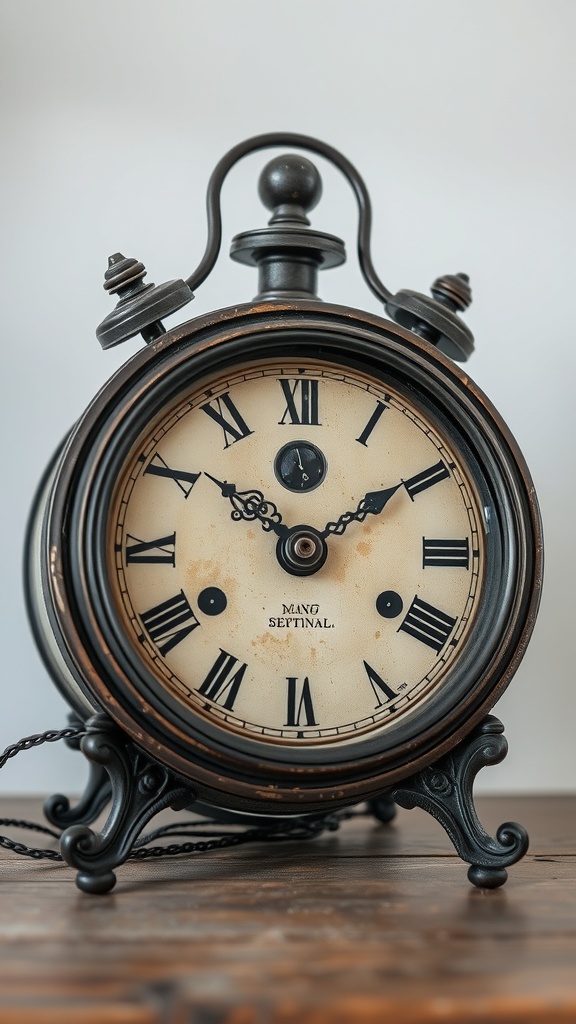
The image of the vintage clock perfectly captures the essence of wabi-sabi, a philosophy that finds beauty in imperfection and transience. This clock, with its worn face and classic Roman numerals, tells more than just time; it tells a story. Each scratch and mark on its surface adds character, reminding us of the moments it has witnessed.
Time is a constant in our lives, yet it often feels fleeting. This clock serves as a gentle reminder to appreciate each passing moment. The design reflects a blend of nostalgia and simplicity, encouraging us to slow down and savor the present.
In wabi-sabi design, objects like this clock are celebrated for their history. They embody the idea that beauty can be found in the aging process. Rather than hiding imperfections, this clock showcases them, inviting us to embrace our own journeys and the marks they leave behind.
Artistic Displays of Natural Objects
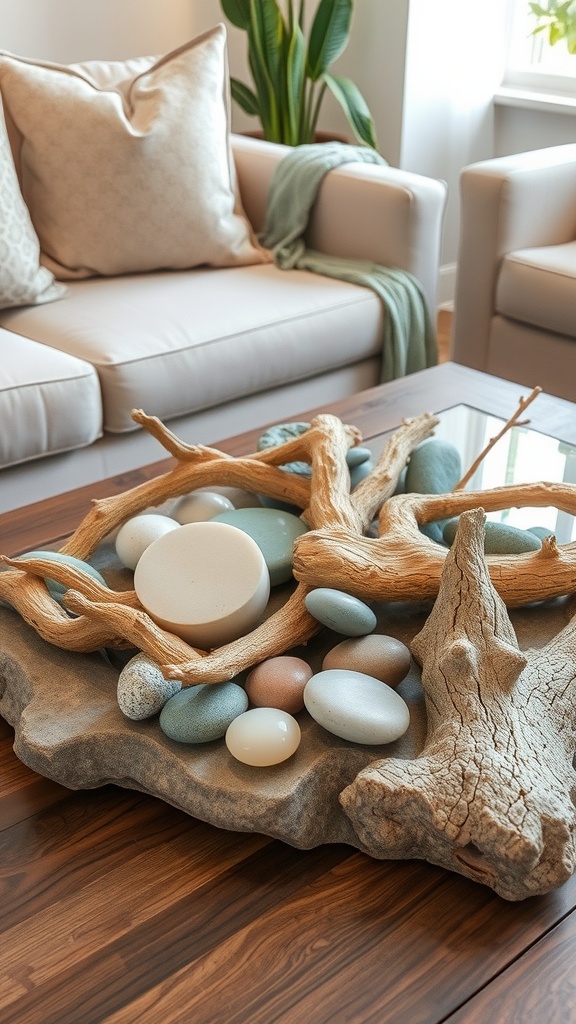
In the realm of Wabi-Sabi design, the beauty of imperfection shines through. This image captures a stunning arrangement of natural elements, showcasing how simple objects can create a striking display. The wooden bowl holds a collection of smooth stones, each with its own unique shape and color. Some stones even have words etched into them, adding a personal touch to the arrangement.
The use of natural materials like wood and stone emphasizes a connection to nature. The organic forms and textures invite a sense of calm and tranquility into the space. This display not only serves as decor but also as a reminder of the beauty found in simplicity and the natural world.
Arranging natural objects like these can be a fun and creative process. You can mix different shapes, sizes, and colors to create your own unique display. Whether you choose to use stones, driftwood, or other natural finds, the key is to embrace their imperfections and let them tell their own story.
Cohesive Yet Eclectic Decor
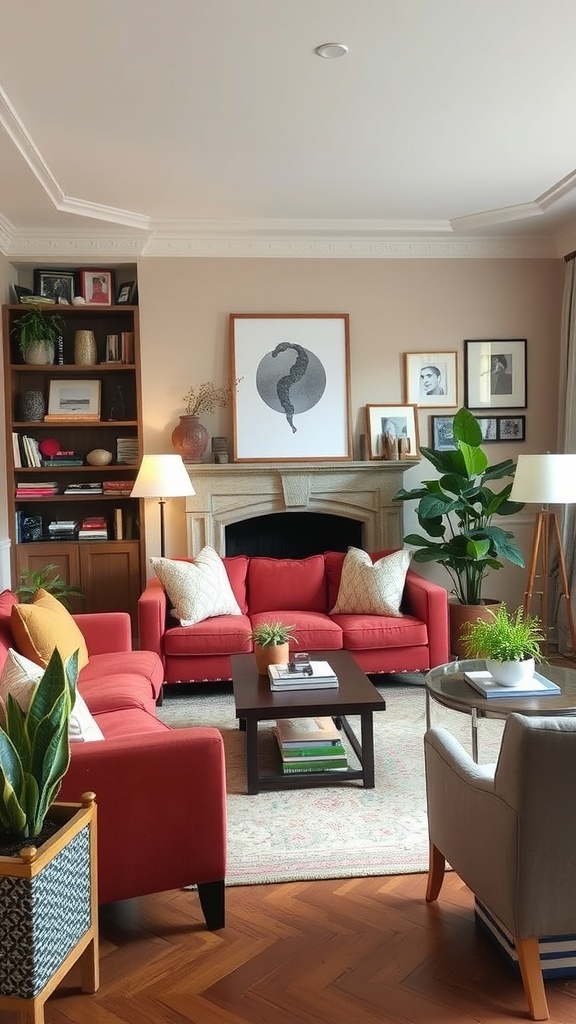
The image showcases a cozy living room that beautifully embodies the wabi-sabi philosophy. This style celebrates imperfections and the beauty of natural elements. The room features a mix of textures and colors, creating a warm and inviting atmosphere.
The red sofas stand out, providing a pop of color against the soft beige walls. They are complemented by neutral cushions, adding comfort and style. A wooden coffee table sits at the center, offering a practical yet stylish focal point.
On the walls, a collection of framed art adds character. The artwork varies in style, yet it all feels harmonious. This eclectic mix is a key aspect of wabi-sabi, where different elements come together to create a cohesive look.
Plants bring life to the space, enhancing the natural vibe. The greenery contrasts nicely with the furniture, making the room feel fresh and lively. Overall, this decor captures the essence of wabi-sabi, where beauty lies in simplicity and the uniqueness of each piece.
The Role of Silence and Space
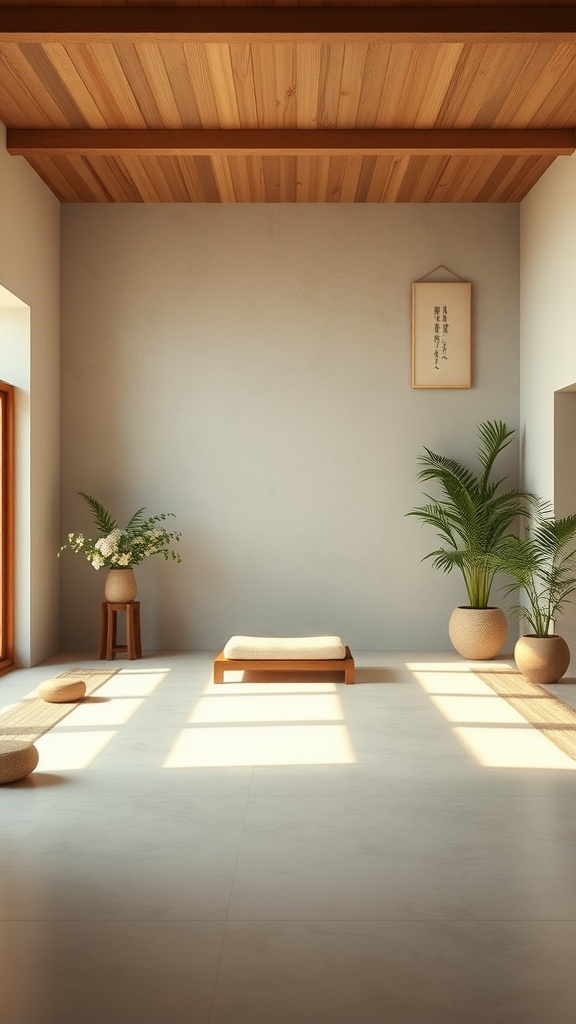
In the image, we see a serene room that embodies the essence of wabi-sabi design. The soft light streaming through the windows creates a peaceful atmosphere, inviting you to pause and reflect. The simple furnishings, like the wooden stool and the cushions, emphasize comfort and tranquility.
Silence and space play a vital role in wabi-sabi. They allow us to appreciate the beauty of imperfections and the natural elements around us. The plants in the room add a touch of life, reminding us of nature’s simplicity.
This design encourages us to embrace minimalism. By reducing clutter, we create a space that feels open and calming. It’s a gentle reminder that sometimes, less is more.
Creating a Sense of Balance
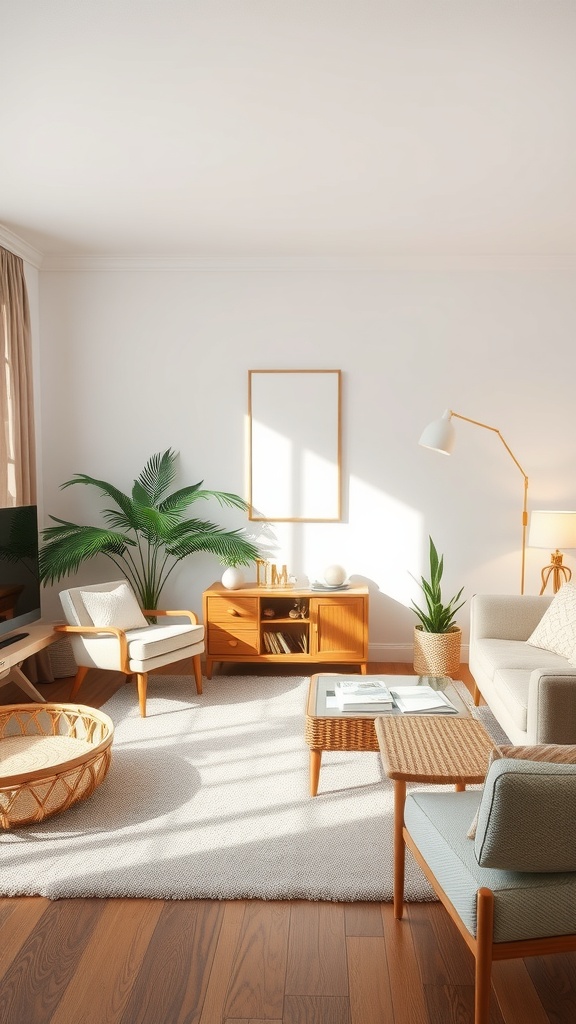
The image showcases a beautifully designed living space that embodies the principles of Wabi-Sabi. The room features a harmonious blend of natural materials and simple forms, creating a calming atmosphere.
Light pours in through the window, casting soft shadows on the warm wooden floor. The furniture is minimal yet inviting, with a cozy sofa and stylish chairs that encourage relaxation. The use of plants adds a touch of life, enhancing the organic feel of the space.
Each element in the room contributes to a sense of balance. The earthy tones and textures work together to create a serene environment. This design approach reminds us that beauty can be found in simplicity and imperfection.
Wabi-Sabi in Outdoor Spaces
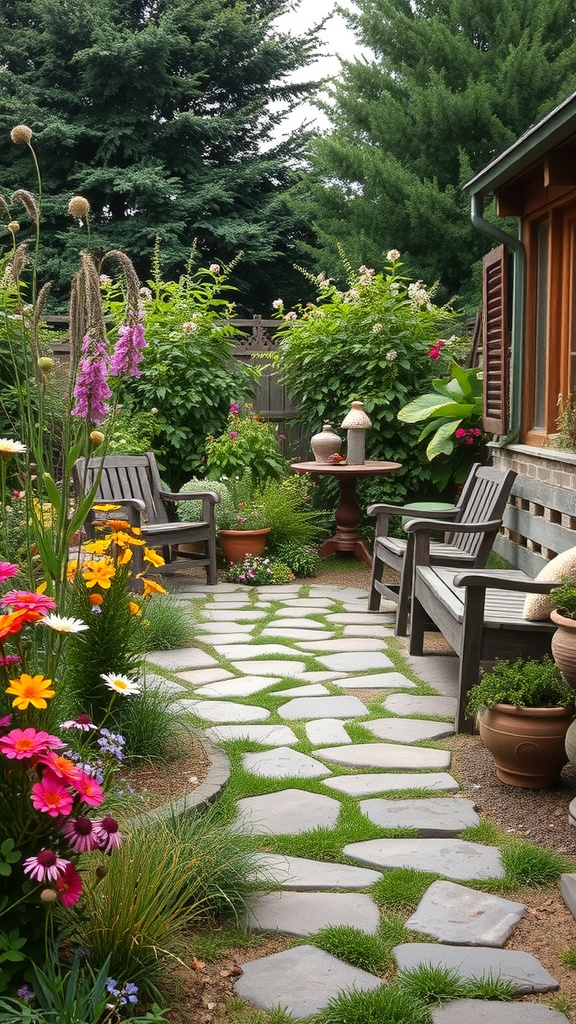
Wabi-sabi is all about finding beauty in imperfection, and outdoor spaces can be a perfect canvas for this philosophy. The image showcases a charming garden path that beautifully embodies wabi-sabi principles. The natural stone pavers, with their uneven shapes and sizes, create a relaxed and inviting atmosphere.
Flanked by vibrant flowers and lush greenery, the path leads to cozy seating areas. The wooden benches, with their simple design, encourage relaxation and connection with nature. This setting invites you to slow down and appreciate the little things, like the gentle rustle of leaves or the colors of blooming flowers.
Incorporating wabi-sabi into outdoor spaces means embracing the natural elements around you. Consider using reclaimed materials or allowing plants to grow in their own wild way. This approach not only enhances the beauty of your garden but also creates a space that feels authentic and alive.
Wabi-Sabi Inspired Artwork
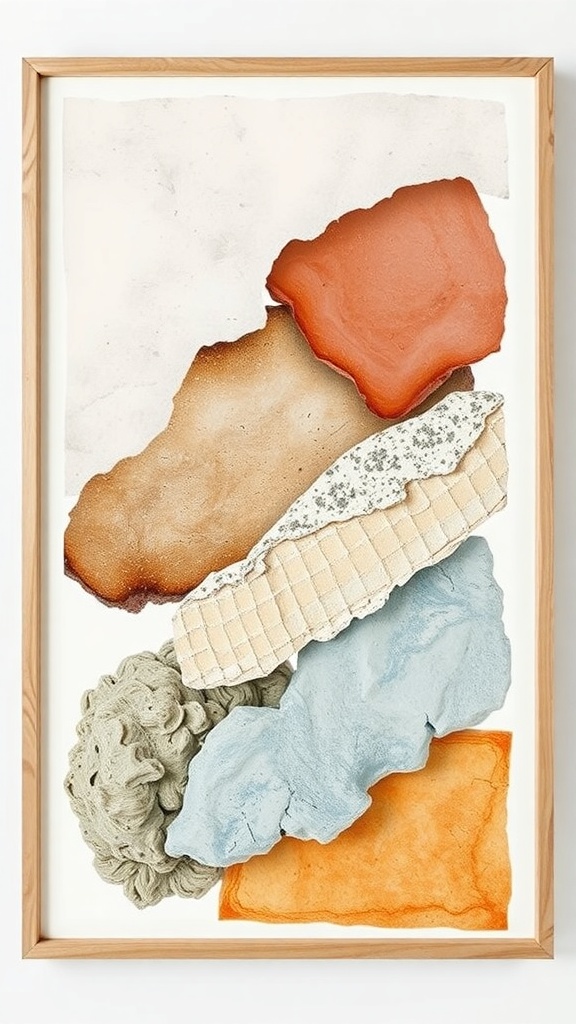
Wabi-sabi celebrates the beauty of imperfection and transience. The artwork in the image reflects this philosophy beautifully. It features organic shapes and earthy colors that evoke a sense of calm and connection to nature.
The design includes soft curves and textures, which create a harmonious balance. The use of muted tones, like terracotta and soft blues, adds warmth and invites viewers to appreciate the simplicity of the piece.
Incorporating natural elements, such as the delicate dried grass, enhances the wabi-sabi aesthetic. This artwork reminds us that beauty can be found in the flawed and the fleeting, encouraging us to embrace life’s imperfections.
